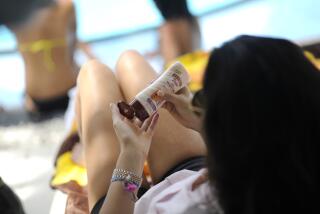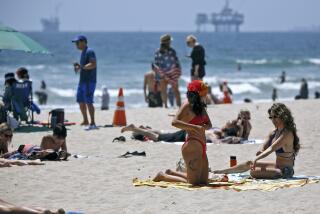With Proper Screening, Anyone Can Enjoy the Sun : Outdoors: Experts warn that there is no such thing as a healthy tan for light-skinned people. Sun blocks will protect against exposure to invisible ultraviolet rays.
- Share via
When Sean Hosmer, 22, began working as a lifeguard at Rocky Neck State Park in East Lyme, Conn., four years ago, the solar social standards were quite different.
“When I first started, there was this big race to get a tan,” he says. “Now people are more careful.”
Even so, the Rocky Neck lifeguards are not exactly skin-protection experts. Hosmer says that they start out with a sunscreen with a sun protection factor of 15 (not strong enough for fair-skinned folks standing nearly naked in the sun for six or more hours) and, over the course of the summer, they work down to an SPF 4 (not strong enough, period).
So, if you are panicking in the undertow, call a lifeguard. If you want to figure out how to protect yourself while having fun outside this summer, read on.
For the light-skinned, there is no such thing as a healthy tan. A tan is your skin scrambling to save itself as best it can from an overdose of the sun’s ultraviolet radiation. Exposure to invisible ultraviolet rays stimulates the production of the skin’s pigment--melanin. This is tanning.
Baking out in the sun for purposes of tanning “is the worst thing you can do,” says Marti Rothe, a dermatologist at the University of Connecticut Health Center in Farmington.
The problem is that the people who want tans--white or light-skinned people--do not tan easily. Caron Grin-Jorgensen, another health center dermatologist, says that for those people, the issue of whether a tan is “protective” is moot because getting there is what does the damage. While you are soaking in rays, you are causing mutations in the pigment cells themselves--cellular changes that may lead to skin cancer later on.
Those who do not need to tan, dark or black-skinned people, are naturally highly resistant to the sun’s ultraviolet radiation. They have and produce lots of melanin. For those people, the production of more melanin in response to sun exposure--tanning--is protective, according to Madhu A. Pathak, a research dermatologist at Harvard University Medical School. (However, the American Academy of Dermatology urges Americans of every skin shade to protect themselves from too much sun.)
While skin cancer is rare among dark-skinned people, it is exploding among light-skinned Americans, and sun exposure is the main culprit. Final figures have not been computed, but the New York-based Skin Cancer Foundation estimates that more than 600,000 new cases of skin cancer were diagnosed in 1991 and that 8,500 Americans died of the disease last year. And depletion of the Earth’s protective ozone layer is making sun exposure more troublesome, because thinning ozone lets more ultraviolet radiation hit the Earth’s surface. Last year the Environmental Protection Agency estimated that ozone loss could create 12 million additional cases of skin cancer among Americans alive today or born before 2030.
The sun’s damage is cumulative. Today’s light-skinned adults probably got too much sun as kids, so they need to be careful from now on. And because most people get most of their sun exposure before age 18, protecting children and adolescents is crucial.
One way to avoid the sun is to stay indoors, but that is no fun. Wide-brimmed hats and long-sleeve shirts and pants help, but it is tough to windsurf with slacks. So we must rely on sunscreens and sun blocks: products with SPF numbers of 15 or higher.
It is not essential to crunch the SPF numbers. They are calculated on something dermatologists call the minimal erythema dose, or MED, which is the amount of sun exposure you would receive in one day to get a slight sunburn (erythema).
If you multiply the SPF number by the amount of time it takes you to get a slight burn, you get a rough idea how long the same burn will take after you have applied the sunscreen.
Pathak says that there are almost too many factors to produce an average MED as measured in time-in-the-sun: season, time of day, altitude, geography and surroundings. But he says that 20 minutes--unprotected at noon, in midsummer, in the northern United States--is a rough MED for fair-skined, blue-eyed types. Multiply the sun protection factor number on your sunscreen (let’s say 15) by your MED time (20 minutes), and you get five hours. So 20 minutes unprotected gives you the same burn you’d get in five hours with an SPF 15 sunscreen (so you would have to spend less than five hours in the sun to avoid the burn).
You can see why dermatologists encourage everyone to use a sunscreen with an SPF of 15 or higher. Some suggest that light-skinned individuals start with SPF 30; it doubles the amount of sun exposure they can safely receive. The Federal Drug Administration will come out with new proposed regulations involving sunscreen later this year that will, among other things, encourage fair-skinned Americans to use products with SPFs higher than 15.
But SPF isn’t everything. Some of the chemicals that block the sun’s rays may not agree with your skin. Dermatologists recommend that sunscreen not be used on children younger than 6 months old--their skin is especially permeable. Newborns should be kept out of the sun.
Since sun blocks come in liquids, gels, creams and sprays, some may block skin pores and promote acne. If you find this to be a problem, look for “non-comedogenic” on the label. Penny Lowenstein, a dermatologist, recommends using an alcohol-based sunscreen if thicker concoctions cause acne.
If your summer activities involve water sports, you will want to use a “waterproof” sunscreen. Dr. Darrell Rigel, a clinical professor of dermatology at New York University Medical Center, doubts that any of these products are truly waterproof--retaining their SPF protection after 80 minutes in the water. He says that 40 minutes is more realistic and, in any case, you should reapply sunscreen after splashing around.
More to Read
Sign up for The Wild
We’ll help you find the best places to hike, bike and run, as well as the perfect silent spots for meditation and yoga.
You may occasionally receive promotional content from the Los Angeles Times.






